Travelers often keep mementos from their journeys to reminisce later on. Finding ways to document the experience can even add more fun in the moment. This is especially true for family travel, as these relics become prevailing records of pivotal chapters in kids’ lives. If your family makes regular visits to national parks, the Passport To Your National Parks not only adds an extra dimension to travel but creates tangible memories to revisit.
The Eastern National nonprofit first launched the guidebook in 1986. Since then, it’s become a bestseller prompting travelers to collect ink stamps from national park visitor centers to mark each excursion. While it immerses you further into each national park visit, that’s not all the Passport provides.
Once you start flipping through the pages of the Classic Edition, it’s clear that the Passport To Your National Parks is made by national park lovers, for national park lovers. It starts by sharing national park history, mentioning their origins via Yellowstone National Park — the world’s first national park — created in 1872.
“Since Yellowstone, more than 400 sites have become part of the National Park System,” it reads. “Some sites commemorate an influential person, event, or place. Other sites preserve America’s wildlife and diverse beauty. Each site reminds us of the things we cherish — our history and environment.”
The Passport’s initial text reflects its well-rounded approach. It affirms why we love visiting national parks, exploring how these U.S. marvels inspired other countries to preserve their own precious resources and underscoring the need to preserve them for the future. From there,
Keep reading, and you’ll find a brief how-to on using the Passport: “Whenever you visit a national park, be sure to get your Passport canceled. These ink markings record the name of the park and the date of your visit.”
The Passport’s blank pages for stamping include spots reserved for corresponding regional/national stamps, issued each year on a single sheet.
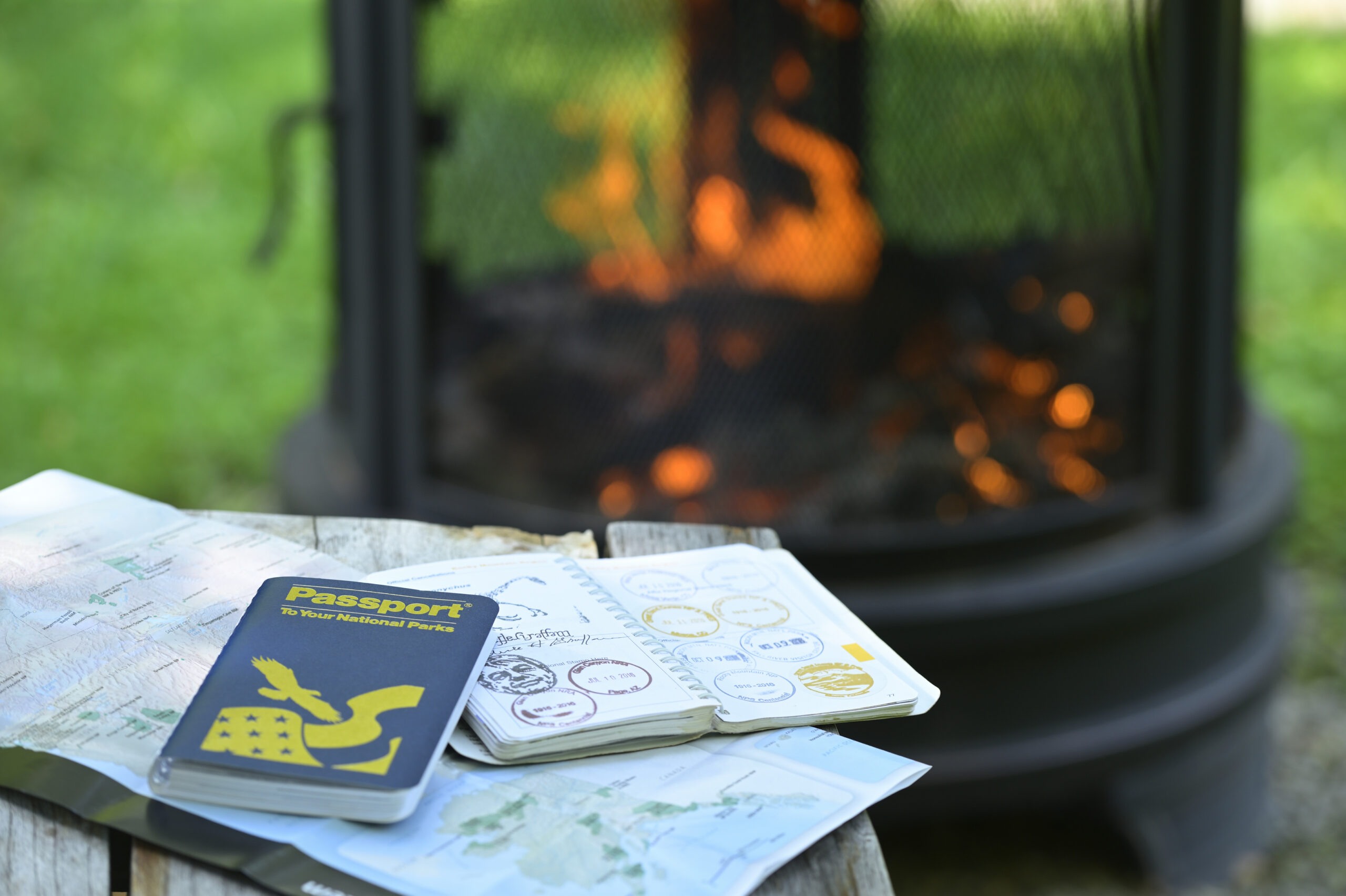
Photo courtesy of America’s National Parks
While many of the Passport’s pages are dedicated to stamps and cancellations, it’s clear how travelers can go further to “discover more about the parks near your home and throughout the nation,” per the introduction.
The Passport is divided into nine geographic travel regions, making it easy to quickly find a specific park or part of the country. Each section kicks off with a comprehensive list of every national park in the region and a few pages focused on their history. You’ll also notice a handy map with numbers corresponding to each national park in the list.
Once you’ve flipped through each region, you’ll see a list of long-distance trails within the National Trails System paired with specific addresses. Finally, the inner side of the back cover includes a list of commonly used park abbreviations that could prove useful during your visits.
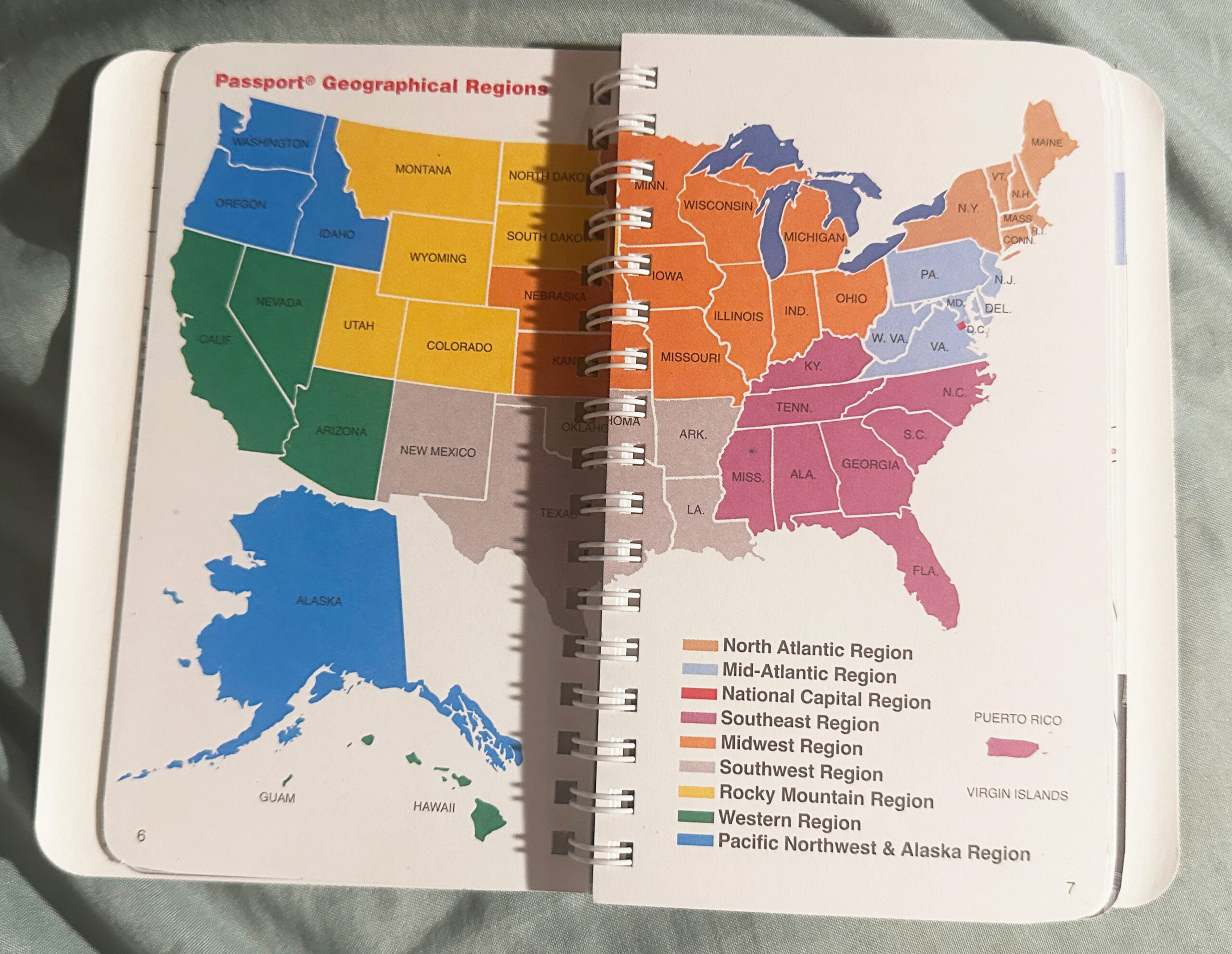
I was immediately struck by the size and feel of the Passport. It shares similar dimensions with a real passport (albeit with far more pages). It’s compact and comfortable to flip through. The binding feels strong, and the paper is sturdy and thick. It’s clear that this Passport is built to withstand the travel adventures that await.
The Passport was obviously designed with care, from folks who share the same love and commitment to national parks as their intended audience. The passages of text and practical information really push the Passport over the top. There’s enough for it to function as a basic resource or guide, whereas it might feel somewhat hollow solely as a book of blank pages to fill.
The details come together nicely. The inner side of the front cover reads, “This Passport belongs to,” followed by a spot for your name and another to attach a photo. There’s a transparent sleeve to the right, allowing owners to store their stamps and other small treasures.
As a designer myself, I marveled over the visual experience. The text is a simple sans-serif, large enough to read clearly without looking tacky or crowding the page. After the introduction, you’ll see a United States map spanning across two pages with color-coded regions. Flip to a specific section, and you’ll see these respective colors in a region’s headers and page tabs for quick navigation.
The pictures included in the regional history sections are crystal clear. The layout features them prominently, but it doesn’t feel too busy or at odds with the text. Every design element is crisp and bright — sleek and united, but never flashy. They support the Passport’s main function — an intentional supplement, not an afterthought.
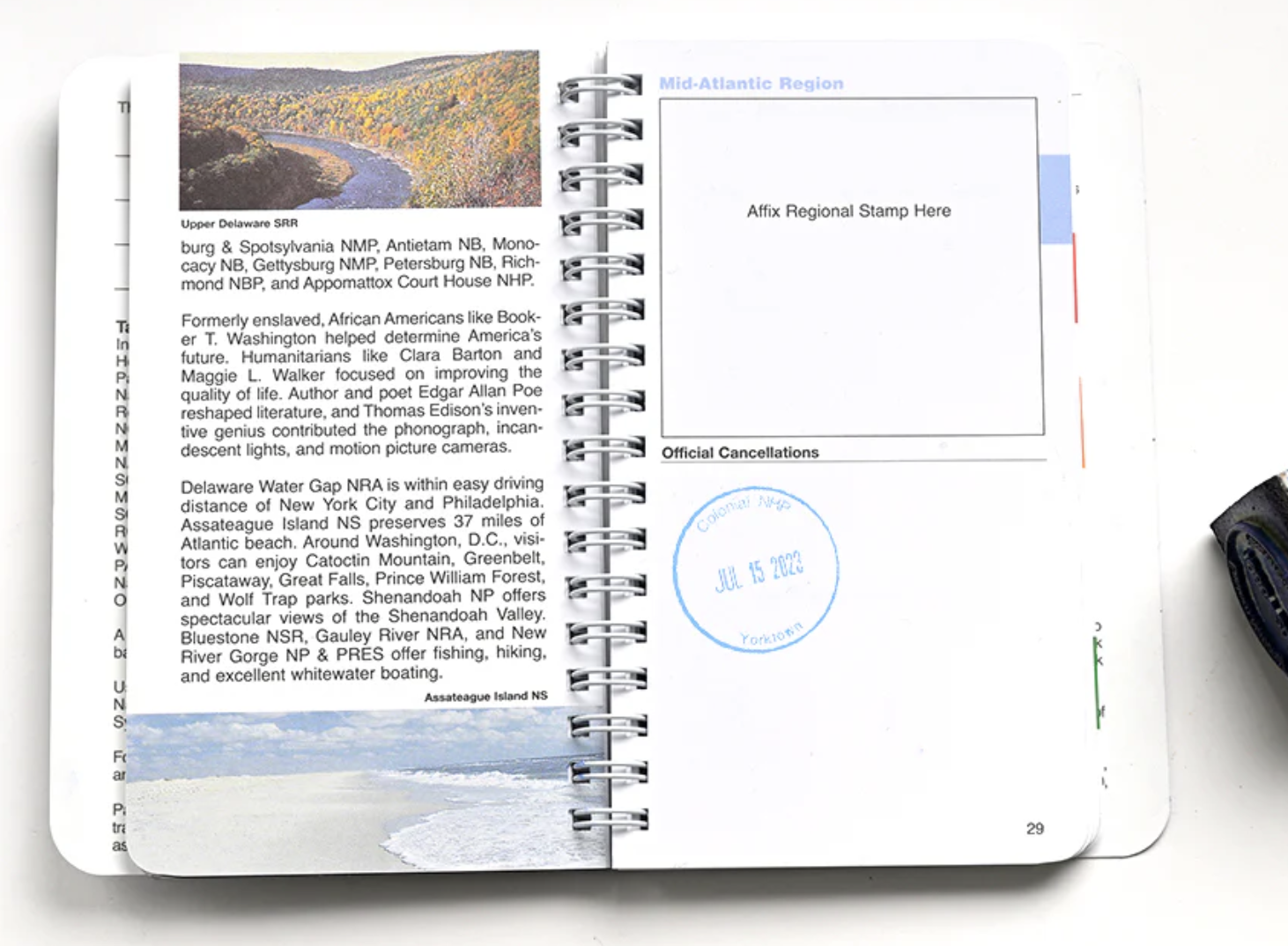
Inside the Classic Edition / Photo courtesy of America’s National Parks
While kids could use the Classic Edition themselves, it’s reminiscent of a guide or reference book — best for adults, teens, and older kids. Youngsters will likely feel a bit underwhelmed by its subtleties, but The Junior Ranger Edition takes an alternative approach.
The Junior Ranger Edition’s size and overall design mirrors a children’s activity book. It serves the same function as the Classic Edition with similar sections. There’s an intro, including a how-to and background on national parks in the United States. The Junior Ranger Edition also includes the same regional sections with full park lists, maps, and regional history (written in a more digestible, kid-friendly tone).
The Junior Ranger Edition really leans into the interactive element, prompting kids to become a Junior Ranger when they visit each park. They can obtain a Junior Ranger booklet at a national park visitor center, complete the activities, let a ranger check the booklet, take the Junior Ranger pledge, and receive an official Junior Ranger badge and certificate before the visit ends.
The regional lists are larger, and every park includes a bubble and square for kids to track their visits and the Junior Ranger Programs they’ve completed, respectively.
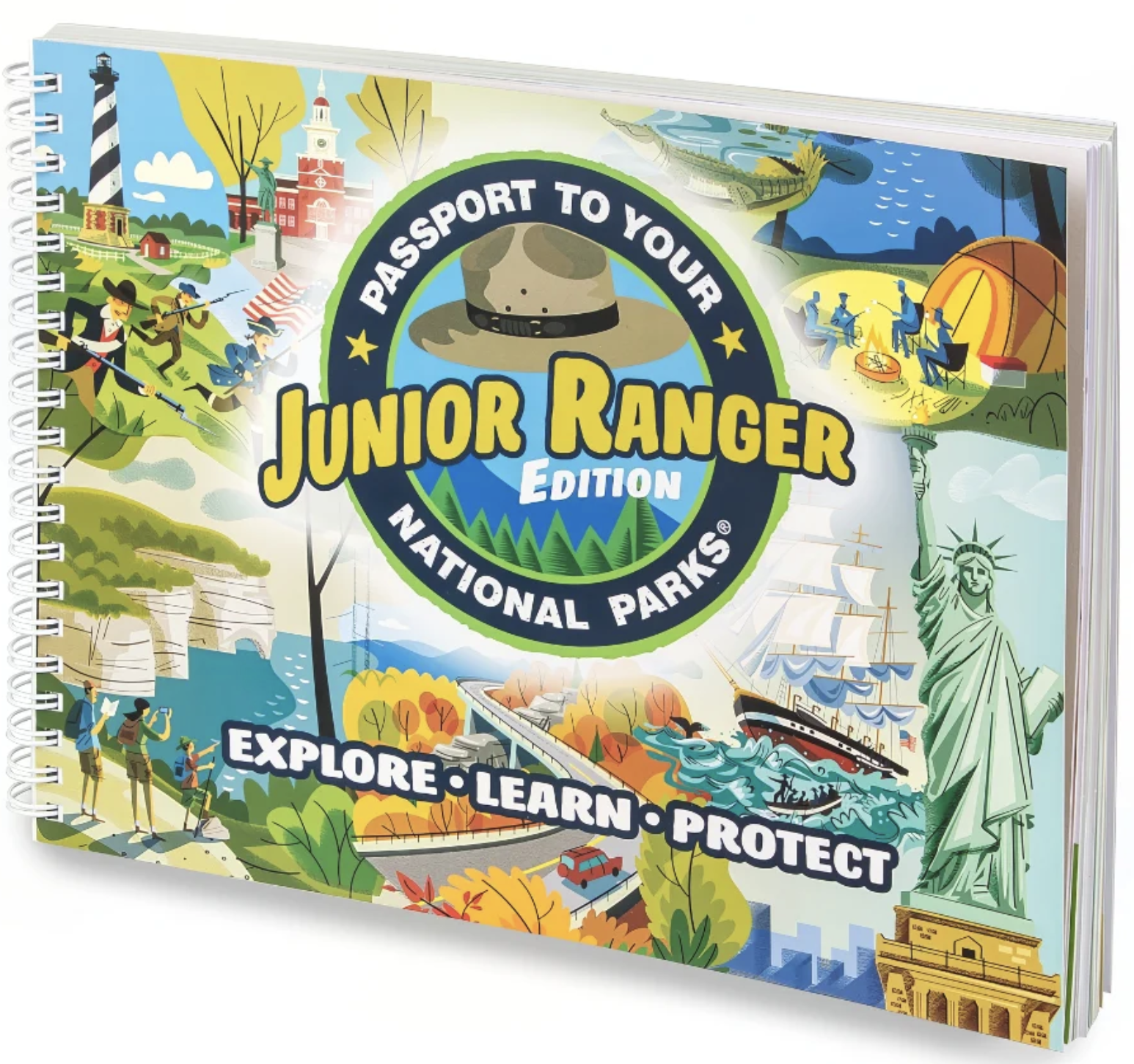
Passport To Your National Parks Junior Ranger Edition / Photo courtesy of America’s National Parks
The initial background sections tackle additional subjects such as park rangers, park activities and recreation, park wildlife, safety tips, and more. Each topic comes with at least one or two related activities for kids to tackle on the page, applying the newfound knowledge to their own life and experiences:
The section on natural beauty includes a full page prompting kids to draw their own “scene of natural beauty” and a list of natural phenomena (mountains, forests, oceans, full moons, etc.) to check off what they’ve seen. After the section on national parks’ connection to U.S. history, kids can create a timeline of important events in their life and draft their own Declaration of Independence with personalized rules.
These activities are just a fraction of this Edition’s hands-on additions. This approach could definitely help kids nurture a love for national parks at a young age, in a way the Classic Edition may not.
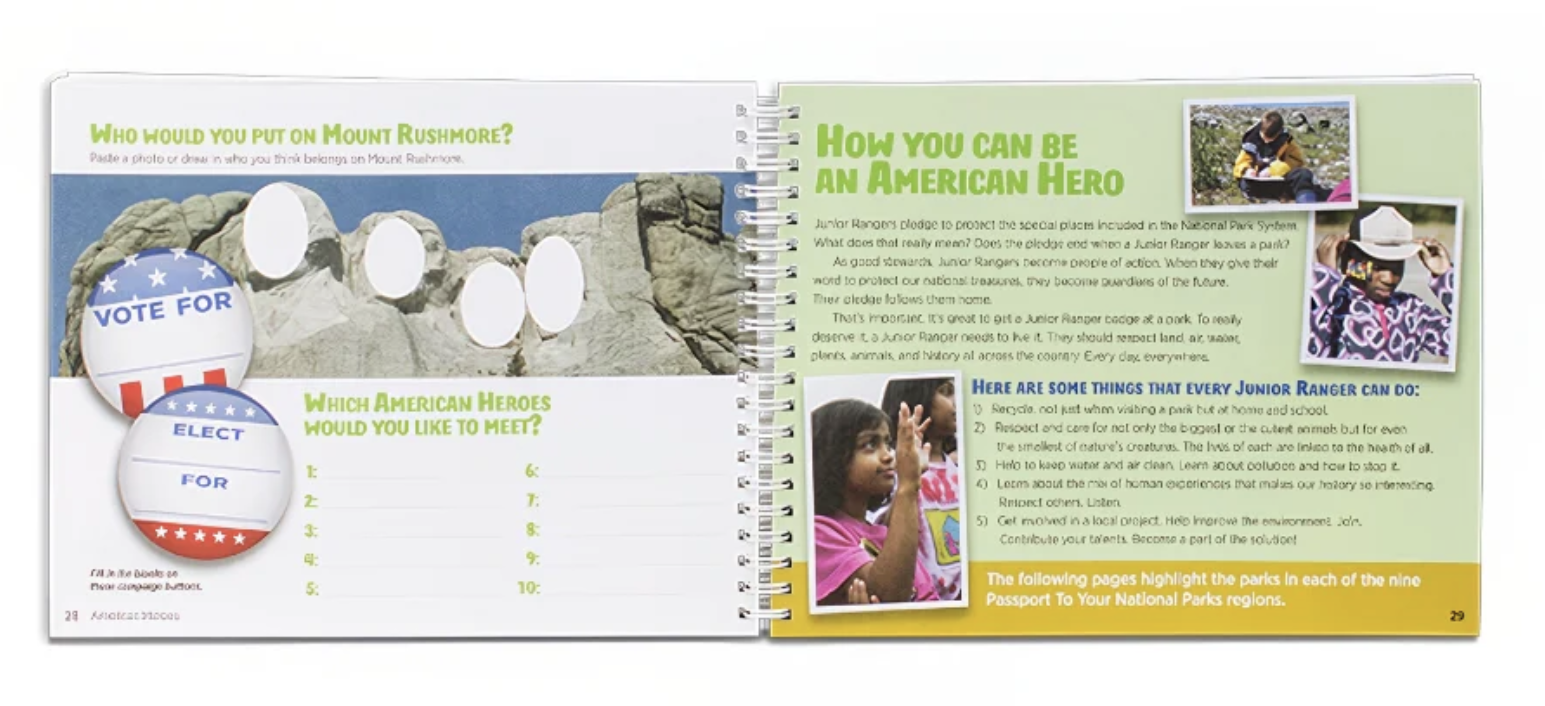
Inside of the Junior Ranger Edition / Photo courtesy of America’s National Parks
The Passport To Your National Park is clearly geared toward a specific type of traveler. It’s niche. Unless you find yourself visiting at least one to two national parks a year, it may not be for you. Then again, the $14.95 price point (or $17.95 for the Junior Ranger Edition) is a low-pressure investment. If you plan to visit more national parks in the future or simply like the idea of documenting national park trips (however infrequent), maybe it’s worth picking up anyway.
As a resource, the Classic Edition mostly functions as a quick reference to national parks and their locations throughout the country. The information is practical and gives the Passport more substance. Still, don’t expect in-depth descriptions of individual parks or detailed guides on what to do once you’re there. You shouldn’t expect a national park guidebook, but the Passport isn’t going for that anyway.
There’s no doubt that travelers who make frequent visits to national parks — especially those set on visiting as many as they can — will appreciate the Passport most. It’s a simple and effective way to document your national park experiences. National park lovers looking to memorialize trips in one place or add an interactive element to their travel should get their hands on this Passport, no question.
The Junior Ranger Edition and Program centers kids aged 5 through 13, though travelers of any age can participate. It obviously depends on the kid, but I would imagine most kids older than 10 or 11 would prefer a Classic Edition.
That said, this alternative option knows what it’s doing. The Junior Ranger Edition offers the same basic function as the Classic, to document national park travel. It completely transforms every other element to promote maximum excitement and engagement among younger travelers. Kids can truly immerse themselves into the world of national parks, both inside the pages and in-person through the Junior Ranger Program. This age-appropriate option feels much more effective to foster children’s long-term interest and investment in national parks.
A final thought: I could also see parents purchasing both the Junior Ranger and Classic Editions for their kids, simultaneously documenting park visits in both Passports. Little ones can make the most of their experience with the Junior Ranger Edition. When the time comes, they can look forward to graduating to a more mature version without sacrificing the precious memories from their younger years.
The latest versions of Passport To Your National Park Classic Edition and Junior Ranger Edition are available via the America’s National Parks website. The site also offers Explorer Edition and Classic Leather Cover (if in stock), along with a discounted Classic and Junior Ranger Edition combo pack.
To learn more about the Passport To Your National Park and national parks in general, visit Eastern National, America’s National Parks, and the National Park Service online.
—
 About the Author: Keegan Williams is a freelance editor and writer based in Los Angeles. They have written for publications including HuffPost, LGBTQ Nation, and High Times. Keegan has a passion for fitness. They are also immersed in LA’s underground dance scene and dabble as a DJ with a focus on percussive, high-energy techno and electronic music genres.
About the Author: Keegan Williams is a freelance editor and writer based in Los Angeles. They have written for publications including HuffPost, LGBTQ Nation, and High Times. Keegan has a passion for fitness. They are also immersed in LA’s underground dance scene and dabble as a DJ with a focus on percussive, high-energy techno and electronic music genres.
You can find them at keeganmwilliams.com or on Instagram @promwitch.
The post Review: Passport To Your National Parks (Classic and Junior Ranger Editions) appeared first on Road Trips For Families.
The Eastern National nonprofit first launched the guidebook in 1986. Since then, it’s become a bestseller prompting travelers to collect ink stamps from national park visitor centers to mark each excursion. While it immerses you further into each national park visit, that’s not all the Passport provides.
Passport To Your National Parks: First Impressions
Once you start flipping through the pages of the Classic Edition, it’s clear that the Passport To Your National Parks is made by national park lovers, for national park lovers. It starts by sharing national park history, mentioning their origins via Yellowstone National Park — the world’s first national park — created in 1872.
“Since Yellowstone, more than 400 sites have become part of the National Park System,” it reads. “Some sites commemorate an influential person, event, or place. Other sites preserve America’s wildlife and diverse beauty. Each site reminds us of the things we cherish — our history and environment.”
The Passport’s initial text reflects its well-rounded approach. It affirms why we love visiting national parks, exploring how these U.S. marvels inspired other countries to preserve their own precious resources and underscoring the need to preserve them for the future. From there,
Keep reading, and you’ll find a brief how-to on using the Passport: “Whenever you visit a national park, be sure to get your Passport canceled. These ink markings record the name of the park and the date of your visit.”
The Passport’s blank pages for stamping include spots reserved for corresponding regional/national stamps, issued each year on a single sheet.

Photo courtesy of America’s National Parks
Using the Passport as a National Parks Resource
While many of the Passport’s pages are dedicated to stamps and cancellations, it’s clear how travelers can go further to “discover more about the parks near your home and throughout the nation,” per the introduction.
The Passport is divided into nine geographic travel regions, making it easy to quickly find a specific park or part of the country. Each section kicks off with a comprehensive list of every national park in the region and a few pages focused on their history. You’ll also notice a handy map with numbers corresponding to each national park in the list.
Once you’ve flipped through each region, you’ll see a list of long-distance trails within the National Trails System paired with specific addresses. Finally, the inner side of the back cover includes a list of commonly used park abbreviations that could prove useful during your visits.

Small Details, Functionality, and Design
I was immediately struck by the size and feel of the Passport. It shares similar dimensions with a real passport (albeit with far more pages). It’s compact and comfortable to flip through. The binding feels strong, and the paper is sturdy and thick. It’s clear that this Passport is built to withstand the travel adventures that await.
The Passport was obviously designed with care, from folks who share the same love and commitment to national parks as their intended audience. The passages of text and practical information really push the Passport over the top. There’s enough for it to function as a basic resource or guide, whereas it might feel somewhat hollow solely as a book of blank pages to fill.
The details come together nicely. The inner side of the front cover reads, “This Passport belongs to,” followed by a spot for your name and another to attach a photo. There’s a transparent sleeve to the right, allowing owners to store their stamps and other small treasures.
As a designer myself, I marveled over the visual experience. The text is a simple sans-serif, large enough to read clearly without looking tacky or crowding the page. After the introduction, you’ll see a United States map spanning across two pages with color-coded regions. Flip to a specific section, and you’ll see these respective colors in a region’s headers and page tabs for quick navigation.
The pictures included in the regional history sections are crystal clear. The layout features them prominently, but it doesn’t feel too busy or at odds with the text. Every design element is crisp and bright — sleek and united, but never flashy. They support the Passport’s main function — an intentional supplement, not an afterthought.

Inside the Classic Edition / Photo courtesy of America’s National Parks
Passport To Your National Parks: Junior Ranger Edition
While kids could use the Classic Edition themselves, it’s reminiscent of a guide or reference book — best for adults, teens, and older kids. Youngsters will likely feel a bit underwhelmed by its subtleties, but The Junior Ranger Edition takes an alternative approach.
First Looks, Comparisons, and the Junior Ranger Program
The Junior Ranger Edition’s size and overall design mirrors a children’s activity book. It serves the same function as the Classic Edition with similar sections. There’s an intro, including a how-to and background on national parks in the United States. The Junior Ranger Edition also includes the same regional sections with full park lists, maps, and regional history (written in a more digestible, kid-friendly tone).
The Junior Ranger Edition really leans into the interactive element, prompting kids to become a Junior Ranger when they visit each park. They can obtain a Junior Ranger booklet at a national park visitor center, complete the activities, let a ranger check the booklet, take the Junior Ranger pledge, and receive an official Junior Ranger badge and certificate before the visit ends.
The regional lists are larger, and every park includes a bubble and square for kids to track their visits and the Junior Ranger Programs they’ve completed, respectively.

Passport To Your National Parks Junior Ranger Edition / Photo courtesy of America’s National Parks
Junior Ranger Edition: Hands-On, Kid-Friendly Additions
The initial background sections tackle additional subjects such as park rangers, park activities and recreation, park wildlife, safety tips, and more. Each topic comes with at least one or two related activities for kids to tackle on the page, applying the newfound knowledge to their own life and experiences:
The section on natural beauty includes a full page prompting kids to draw their own “scene of natural beauty” and a list of natural phenomena (mountains, forests, oceans, full moons, etc.) to check off what they’ve seen. After the section on national parks’ connection to U.S. history, kids can create a timeline of important events in their life and draft their own Declaration of Independence with personalized rules.
These activities are just a fraction of this Edition’s hands-on additions. This approach could definitely help kids nurture a love for national parks at a young age, in a way the Classic Edition may not.

Inside of the Junior Ranger Edition / Photo courtesy of America’s National Parks
The Verdict
The Passport To Your National Park is clearly geared toward a specific type of traveler. It’s niche. Unless you find yourself visiting at least one to two national parks a year, it may not be for you. Then again, the $14.95 price point (or $17.95 for the Junior Ranger Edition) is a low-pressure investment. If you plan to visit more national parks in the future or simply like the idea of documenting national park trips (however infrequent), maybe it’s worth picking up anyway.
Classic Edition
As a resource, the Classic Edition mostly functions as a quick reference to national parks and their locations throughout the country. The information is practical and gives the Passport more substance. Still, don’t expect in-depth descriptions of individual parks or detailed guides on what to do once you’re there. You shouldn’t expect a national park guidebook, but the Passport isn’t going for that anyway.
There’s no doubt that travelers who make frequent visits to national parks — especially those set on visiting as many as they can — will appreciate the Passport most. It’s a simple and effective way to document your national park experiences. National park lovers looking to memorialize trips in one place or add an interactive element to their travel should get their hands on this Passport, no question.
Junior Ranger Edition
The Junior Ranger Edition and Program centers kids aged 5 through 13, though travelers of any age can participate. It obviously depends on the kid, but I would imagine most kids older than 10 or 11 would prefer a Classic Edition.
That said, this alternative option knows what it’s doing. The Junior Ranger Edition offers the same basic function as the Classic, to document national park travel. It completely transforms every other element to promote maximum excitement and engagement among younger travelers. Kids can truly immerse themselves into the world of national parks, both inside the pages and in-person through the Junior Ranger Program. This age-appropriate option feels much more effective to foster children’s long-term interest and investment in national parks.
A final thought: I could also see parents purchasing both the Junior Ranger and Classic Editions for their kids, simultaneously documenting park visits in both Passports. Little ones can make the most of their experience with the Junior Ranger Edition. When the time comes, they can look forward to graduating to a more mature version without sacrificing the precious memories from their younger years.
The latest versions of Passport To Your National Park Classic Edition and Junior Ranger Edition are available via the America’s National Parks website. The site also offers Explorer Edition and Classic Leather Cover (if in stock), along with a discounted Classic and Junior Ranger Edition combo pack.
To learn more about the Passport To Your National Park and national parks in general, visit Eastern National, America’s National Parks, and the National Park Service online.
—
 About the Author: Keegan Williams is a freelance editor and writer based in Los Angeles. They have written for publications including HuffPost, LGBTQ Nation, and High Times. Keegan has a passion for fitness. They are also immersed in LA’s underground dance scene and dabble as a DJ with a focus on percussive, high-energy techno and electronic music genres.
About the Author: Keegan Williams is a freelance editor and writer based in Los Angeles. They have written for publications including HuffPost, LGBTQ Nation, and High Times. Keegan has a passion for fitness. They are also immersed in LA’s underground dance scene and dabble as a DJ with a focus on percussive, high-energy techno and electronic music genres.You can find them at keeganmwilliams.com or on Instagram @promwitch.
The post Review: Passport To Your National Parks (Classic and Junior Ranger Editions) appeared first on Road Trips For Families.
